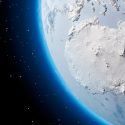Let’s face it. There are A LOT of us, and it’s getting more than a little crowded. Right now, there are over 7.7 billion people on Earth, and the United Nations predicts we’ll have 8.6 billion people sometime in 2030. And that’s a problem.
Many scientists think Earth can only support 9 to 10 billion people. We’re running out of room.
But, could there be a way to get more land to accommodate our ever-increasing population? Enter the atoll, made of doughnut-shaped underwater mountains, and islands, formed by underwater volcanoes. Could these submerged rings of land be just the thing we need to create more living space?
What if we could drain the world’s largest atoll? Would we benefit from this? Or would it make things way worse?
An atoll forms when an underwater volcano (also known as a seamount) erupts, with the lava from the volcano hardening when it hits the water. After many eruptions, the seamount grows until it rises above the water. You’ve probably seen one of these before. We call them islands.
The hardened lava under the water then becomes a home for many living organisms, especially corals. But more on them later.
As the corals grow, they form a fringing reef around the island. Over time the reef continues to grow, and the island begins to shrink.
As the island shrinks, the reef remains and the corals begin to grow upwards. Then, it becomes a coral rim, which means you’ve got a nice chunk of land accompanied by a warm, shallow and salty lagoon — an atoll.
Atolls are some of the most beautiful habitats in the ocean. They’re some of the most evolved coral reef systems in the world, homes for many kinds of plants and sea creatures.
The largest of them all is none other than the Great Chagos Bank. This atoll has a massive area of 12,642 square km (4,881 square mi). Could this be our new redevelopment project?
Well, if we were to drain this atoll and fill it with sand, concrete, or any other solid material, we’d have some brand new land there. The development of these new areas would begin immediately, with the economic boost coming soon after.
It would go something like this. More land means more space for people. More people means more development. More development means more jobs. And more jobs mean more money.
So, sounds like a winner, right? Well, not so much.
Remember those coral reefs I mentioned before? Well, we kind of need them. And when I say “kind of,” I mean we absolutely need coral reefs. But if we drain the water around them, the reefs die. About 80% of the oxygen you breathe comes from the ocean, not from land.
We need healthy oceans to produce oxygen. Healthy oceans need coral reefs. Do you see what I’m getting at?
And if you’re still hung up on the lost profits from not draining the atoll, get this: coral reefs are essential breeding, spawning and feeding grounds for more than 4,000 species of fish. Those fish are a major source of food for over a billion people worldwide. The National Marine Fisheries Service estimates the annual commercial value from coral reefs at over $100 million.
And that’s not even getting into how they act as coastline bodyguards. Healthy coral reefs have rough surfaces and complex structures that scatter much of the force of incoming waves. This means these reefs act as buffers for currents, waves and storms. Coastlines protected by reefs are a lot more stable.
So, it’s best that we don’t kill these silent heroes of the sea. Just because we can do something, doesn’t mean we should.
Draining an atoll is certainly possible. But draining the world’s atolls, would have catastrophic effects worldwide. So maybe we should rethink this. What if, instead of draining water out of the atolls, water became a new home for us?
Sources
- “The Largest Atolls In The World”. Sousa, Gregory, Country Codes, Did Know?, and World Facts. 2020. Worldatlas.
- “Why Are Coral Reefs So Important? – Coral Guardian”. 2020. Coral Guardian.
- “Half of the Great Barrier Reef has died since 2016 — here’s what happens if all coral reefs on Earth die off”. 2020. Business Insider.
- “How Many People Can Earth Support?”. Wolchover, Natalie. 2011. livescience.com.



























